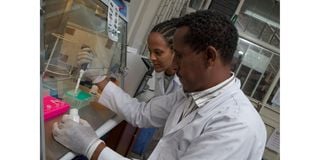Hope for kala-azar patients as new treatment is discovered

Arega Yeshanew (right) the Head of Laboratory at the Leishmaniasis Treatment Centre University of Gondar, Ethiopia in the laboratory with a fellow researcher on May 8, 2020
Patients suffering from visceral leishmaniasis in East Africa can now hope for a better life after a new treatment was discovered.
Visceral leishmaniasis, also known as kala-azar, is the deadliest parasitic killer after malaria in Africa.
It is characterised by irregular bouts of fever, weight loss, enlargement of the spleen and liver, and anaemia.
Some 50,000 to 90,000 new cases of the disease are reported annually, with the highest numbers reported in the eastern African countries of Eritrea, Ethiopia, Kenya, Somalia, South Sudan, Sudan, and Uganda.
But following a successful study conducted in eastern Africa by the non-profit medical research organisation Drugs for Neglected Diseases Initiative (DNDi) and its partners, the number of deaths will be cut considerably.
"We are delighted with the positive results from this clinical trial. It will contribute to our strategic goal of reducing morbidity due to leishmaniasis by 60 per cent by 2025," said Dr Patrick Amoth of Kenya’s Ministry of Health.
Dr Monique Wasunna, DNDi eastern Africa regional director, was equally enthusiastic: "The new combination treatment signifies a historic step forward for dreadfully neglected patient populations.
“After many decades, we have finally included an oral treatment to the regimen, reducing severe side effects and the burden on health systems thanks to decreased hospitalisation time.”
Dr Fabiana Alves, director of the neglected tropical diseases leishmaniasis and mycetoma cluster at DNDi, said: "The journey is not over yet. DNDi and its partners will be beginning clinical trials for new, promising, all-oral treatments for leishmaniasis soon.
"Our goal is to radically transform treatments for visceral leishmaniasis by developing patient-friendly oral therapies that are affordable, safe, and effective in patients in all regions."
The results, announced on Friday, were the culmination of a clinical trial initiated in 2017 in Kenya, Ethiopia, Sudan, and Uganda by the AfriKADIA Consortium with funding from the European and Developing Countries Clinical Trials Partnership (EDCTP).
The results were published in the journal Clinical Infectious Diseases.
Data from Kenya’s Ministry of Health reveals that five million people, mainly children aged five to 15, are at risk of the disease, mostly in nine arid and semi-arid parts of the country.
Scientists say the new treatment for this neglected disease is safer and reduces the number of toxic daily injections and hospitalisation time.
"This new treatment is great news for the thousands of patients affected by visceral leishmaniasis in the region,” said Prof Ahmed Musa of the University of Khartoum and principal investigator of the clinical trial conducted in Sudan.
“It will eliminate one painful and toxic injection from the treatment and is, therefore, safer for those affected.”
The new treatment consists of a combination of two drugs: miltefosine, the only oral drug available for leishmaniasis treatment, and paromomycin, an injectable antibiotic that is 91 per cent effective.
"The current treatment has a significant socio-economic impact as patients are forced to stay in hospital for long periods and miss work or school. With the new treatment, patients will spend less time in hospital," said Prof Musa.
The current first-line treatment in eastern Africa consists of paromomycin, an injectable antibiotic used in combination with sodium stibogluconate (SSG) and administered by injection or intravenously.
It is sub-optimal, as patients may suffer from rare but serious side effects, such as cardiotoxicity, hepatotoxicity and pancreatitis associated with SSG.
The treatment is also difficult to administer because patients must endure two painful injections every day for 17 days.
The World Health Organisation (WHO) says there are three main forms of leishmaniasis. The first is visceral, also known as kala-azar, the most serious form of the disease.
The other strains are cutaneous, the most common, and mucocutaneous.
Leishmaniasis is caused by protozoan parasites transmitted by the bite of infected female Phlebotomine sandflies.
The disease usually affects the poor and is associated with malnutrition, population displacement, poor housing, a weak immune system and poverty.
Leishmaniasis is also linked to environmental changes such as deforestation, the building of dams, irrigation schemes and urbanisation.





